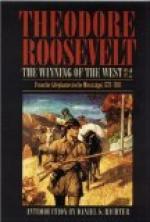That night Crawford’s men slept by their watch-fires in the grove, their foes camping round about in the open prairie. Next morning the British and Indians were not inclined to renew the attack; they wished to wait until their numbers were increased. The only chance of the American militia was to crush their enemies before reinforcements arrived, yet they lay supine and idle all day long, save for an occasional harmless skirmish. Crawford’s generalship was as poor as the soldiership of his men.
Rout of the Whites.
In the afternoon the Indians were joined by one hundred and forty Shawnees. At sight of this accession of strength the disspirited militia Rout gave up all thought of any thing but flight, though they were still equal in numbers to their foes. That night they began a hurried and disorderly retreat. The Shawnees and Delawares attacked them in the darkness, causing some loss and great confusion, and a few of the troops got into the marsh. Many thus became scattered, and next morning there were only about three hundred men left together in a body. Crawford himself was among the missing, so Williamson took command, and hastily continued the retreat. The savages did not make a very hot pursuit; nevertheless, in the afternoon of that day a small number of Indians and Detroit rangers overtook the Americans. They were all mounted. A slight skirmish followed, and the Americans lost eleven men, but repulsed their pursuers. [Footnote: Who were probably at this point much fewer in number than the Americans; Butterfield says the reverse, but his account is untrustworthy on these matters.] After this they suffered little molestation, and reached Mingo Bottom on the 13th of the month. [Footnote: As Butterfield shows, Heckewelder’s account of Crawford’s whole expedition is a piece of sheer romancing.]
Many of the stragglers came in afterwards. In all about seventy either died of their wounds, were killed outright, or were captured. Of the latter, those who were made prisoners by the Wyandots were tomahawked and their heads stuck on poles; but if they fell into the hands of the Shawnees or Delawares they were tortured to death with fiendish cruelty. Among them was Crawford himself, who had become separated from the main body when it began its disorderly night retreat. After abandoning his jaded horse he started homewards on foot, but fell into the hands of a small party of Delawares, together with a companion named Knight.
These two prisoners were taken to one of the Delaware villages. The Indians were fearfully exasperated by the Moravian massacre [Footnote: Haldimand MSS. De Peyster to Haldimand, June 23, 1782.]; and some of the former Moravians, who had rejoined their wild tribesmen, told the prisoners that from that time on not a single captive should escape torture. Nevertheless it is likely that Crawford would have been burned in any event, and that most of the prisoners would have been tortured to death even had the Moravians never been harmed; for such had always been the custom of the Delawares.




